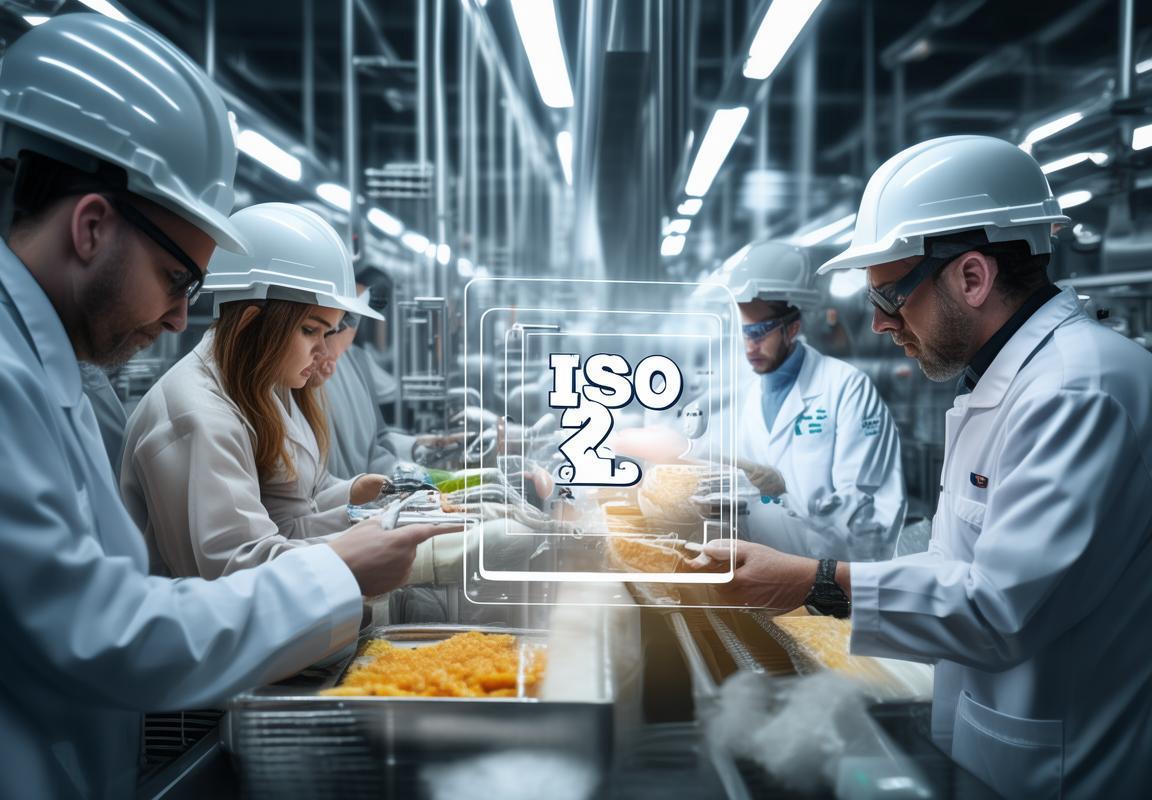Navigating the complexities of food safety in modern manufacturing is a journey that requires a solid understanding of the standards and practices in place. As the global food industry continues to evolve, so does the need for robust safety measures. In this context, the ISO 22000 standard has emerged as a beacon for food safety management, guiding factories and production facilities worldwide. This article delves into the intricacies of ISO 22000, its key components, the challenges faced in its implementation, and the potential for a safer food future.
TheSignificanceofFoodSafetyinManufacturing
In the bustling world of manufacturing, where efficiency and productivity often take center stage, the significance of food safety in the manufacturing process cannot be overstated. It’s not just about adhering to regulations or satisfying customers—it’s about the very essence of trust and health that underpins the entire food industry.
Ensuring food safety in manufacturing is a cornerstone of consumer confidence. When consumers purchase food products, they expect them to be safe to eat. This expectation is not just a legal requirement but a moral imperative. A single instance of a foodborne illness can tarnish a company’s reputation and erode consumer trust, leading to long-term damage to sales and brand loyalty.
The health and well-being of consumers are at the heart of food safety. The food we eat is not just sustenance; it’s a critical component of our daily health. Manufacturing processes that fail to maintain safety standards can lead to foodborne diseases, which range from mild discomfort to severe illness, and in some cases, even death. By prioritizing food safety, manufacturers contribute to a healthier society, reducing the incidence of foodborne illnesses and their associated health risks.
Economic implications are substantial. The food industry is a multi-trillion-dollar global market, and any disruption can have cascading effects. A recall due to contamination or safety lapses can result in millions, if not billions, of dollars in losses. Moreover, the cost of addressing a food safety issue after the fact is far greater than the cost of preventing it through proper safety measures. This is why investing in food safety from the outset is a smart business decision.
Legal and regulatory compliance is non-negotiable. Governments around the world have stringent regulations in place to protect consumers from unsafe food. Non-compliance can lead to fines, legal action, and even the suspension of operations. ISO 22000, for instance, is a globally recognized standard that helps manufacturers meet these legal requirements and demonstrate their commitment to food safety.
Building a strong brand is a gradual process that hinges on consistency and reliability. When a brand is associated with high-quality, safe products, it becomes a beacon of trust. This trust is invaluable in a market where competition is fierce, and differentiation can be achieved through quality and safety. A strong food safety culture within a manufacturing facility can set a brand apart from its competitors.
Consumer loyalty is a fragile asset that must be nurtured. When consumers feel secure in the safety of the food they purchase, they are more likely to remain loyal to a brand. This loyalty translates into repeat business, word-of-mouth referrals, and a stable customer base. A focus on food safety can turn one-time customers into lifelong advocates.
Innovation and continuous improvement are encouraged through a commitment to food safety. Manufacturers that prioritize safety are more likely to invest in research and development to find new ways to enhance their processes and products. This drive for innovation can lead to better products, more efficient operations, and a competitive edge in the market.
Lastly, the global nature of the food industry means that food safety is an international concern. Products are often sourced from multiple countries and distributed worldwide. This interconnectedness requires a standardized approach to food safety that transcends borders. ISO 22000 helps to create a common language and framework for food safety management that is understood and respected globally.
In conclusion, the significance of food safety in manufacturing cannot be overstated. It is a critical factor in maintaining consumer trust, ensuring public health, protecting the economy, building a strong brand, fostering customer loyalty, driving innovation, and complying with international standards. It is an essential element that all manufacturers must embrace to succeed in the modern food industry.

WhatisISO22000?
ISO 22000 is a comprehensive standard designed to ensure food safety across the entire food chain. It is an international benchmark that provides a framework for organizations to establish, implement, maintain, and improve their food safety management systems (FSMS). Here’s a deeper dive into what ISO 22000 entails:
-
Framework and StructureISO 22000 is structured to be compatible with other management system standards, such as ISO 9001 and ISO 14001. It follows a high-level structure, which makes it easier for organizations to integrate it with their existing systems. This structure is based on the Plan-Do-Check-Act (PDCA) cycle, ensuring continuous improvement in food safety practices.
-
Risk-Based ApproachAt its core, ISO 22000 emphasizes a risk-based approach to food safety. This means that organizations must identify, evaluate, and control risks that could lead to food hazards. By doing so, they can prevent food safety issues before they occur, rather than simply responding to problems after they happen.
-
Prerequisite ProgramsISO 22000 recognizes that certain prerequisite programs are essential for maintaining a safe food manufacturing environment. These include hygiene practices, pest control, employee training, and maintenance of equipment. By addressing these areas, organizations can reduce the likelihood of food contamination.
-
Hazard Analysis and Critical Control Points (HACCP)One of the most significant components of ISO 22000 is the implementation of HACCP principles. HACCP is a systematic approach to preventing food safety hazards. It involves identifying critical control points in the production process where food safety risks can be controlled, monitoring these points to ensure control is effective, and taking corrective actions when necessary.
-
Communication and DocumentationEffective communication and documentation are crucial for maintaining a food safety management system. ISO 22000 requires organizations to establish procedures for the communication of food safety information, both internally and with suppliers and customers. Documentation is also essential for tracking the implementation and effectiveness of the FSMS.
-
Management Commitment and ResourcesISO 22000 emphasizes the importance of top management’s commitment to food safety. This includes providing the necessary resources, such as personnel, training, and financial support, to ensure the successful implementation of the FSMS. Management must also demonstrate leadership in food safety by setting the tone for the organization’s food safety culture.
-
Performance EvaluationThe standard requires organizations to regularly evaluate the performance of their FSMS. This includes internal audits, management reviews, and corrective actions. By evaluating performance, organizations can identify areas for improvement and take steps to enhance their food safety practices.
-
Continual ImprovementISO 22000 is designed to drive continual improvement in food safety. Organizations are encouraged to use the PDCA cycle to review and update their FSMS as needed. This ensures that the system remains effective and adapts to any changes in the food industry or regulatory requirements.
-
Global Recognition and AcceptanceAs an international standard, ISO 22000 is recognized worldwide. This means that organizations that achieve certification can demonstrate their commitment to food safety to customers, partners, and regulatory bodies around the globe. This recognition can be a significant competitive advantage in the global marketplace.
-
Integration with Other StandardsISO 22000 can be integrated with other management system standards, allowing organizations to streamline their operations and reduce duplication of efforts. This integration can lead to more efficient use of resources and a more holistic approach to managing various aspects of business operations.
In summary, ISO 22000 is a robust standard that provides a comprehensive framework for managing food safety. By implementing the requirements of ISO 22000, organizations can enhance their ability to control food safety risks, improve customer satisfaction, and ensure compliance with regulatory requirements. The standard’s focus on risk management, continual improvement, and management commitment makes it a valuable tool for any organization involved in the food industry.

KeyComponentsofISO22000
ISO 22000 is a comprehensive framework designed to ensure food safety throughout the entire food chain. It consists of several key components that work together to create a robust food safety management system. Here’s a detailed look at these components:
-
Management Commitment and Leadership: This component emphasizes the importance of top management’s role in establishing and maintaining a food safety management system. It requires that senior management demonstrates leadership and ensures that food safety is a priority across the organization.
-
Food Safety Policy: The organization must develop a clear and documented food safety policy that aligns with its overall business objectives. This policy should be communicated to all employees and should be reviewed and updated as necessary to reflect changes in the organization or the external environment.
-
Hazard Analysis and Critical Control Points (HACCP): HACCP is a systematic approach to identifying, evaluating, and controlling food safety hazards. It involves seven principles, including conducting a hazard analysis, identifying critical control points, establishing critical limits, and verifying the effectiveness of controls.
-
Prerequisite Programs: These are the foundation of a food safety management system. They include good manufacturing practices (GMPs), good hygiene practices (GHPs), and prerequisite programs specific to the organization’s processes. These programs address factors that can affect food safety, such as personnel hygiene, water quality, and pest control.
-
Communication: Effective communication is crucial for the success of ISO 22000. It involves the exchange of information within and outside the organization to ensure that all stakeholders are aware of their roles and responsibilities in maintaining food safety.
-
Operational Control: This component focuses on the implementation of the food safety management system. It includes procedures for controlling the manufacturing process, handling of raw materials, packaging, storage, and distribution. It also covers the monitoring and verification of these controls to ensure they are effective.
-
Validation: Validation is the process of confirming that the food safety management system is effective in controlling food safety hazards. This involves verifying that the system meets the specified requirements and objectives. It can include the review of records, testing, and other forms of assessment.
-
Continuous Improvement: ISO 22000 encourages organizations to continuously improve their food safety management system. This involves reviewing the system’s performance, identifying areas for improvement, and implementing changes to enhance food safety.
-
Training: Training is essential to ensure that all personnel are competent to perform their assigned tasks. Organizations must provide training on food safety, hygiene, and the relevant procedures and practices of the food safety management system.
-
Internal Auditing: Internal audits are conducted to assess the effectiveness of the food safety management system. They help identify areas that need improvement and ensure that the system is compliant with ISO 22000 requirements.
-
Management Review: The management review is a formal meeting where top management reviews the food safety management system. It provides an opportunity to assess the system’s performance, identify any areas of concern, and make decisions regarding the system’s direction.
-
Preventive Actions: This component involves the identification of potential non-conformities and the implementation of preventive actions to address them. It is aimed at preventing future occurrences of non-conformities and improving the overall effectiveness of the food safety management system.
By incorporating these key components, ISO 22000 helps organizations create a culture of food safety, where every aspect of the food chain is scrutinized and controlled to ensure that safe food reaches the consumer.

ImplementingISO22000inYourFactory
Understanding and integrating the ISO 22000 standard into your factory requires a comprehensive approach. Here’s a breakdown of the key steps involved:
1. Familiarize Yourself with ISO 22000:2018 RequirementsBefore diving into implementation, it’s crucial to have a thorough understanding of the ISO 22000:2018 standard. This includes grasping the principles of food safety management and the specific requirements outlined in the standard.
2. Conduct a Current State AssessmentAssess your factory’s current food safety practices, identifying areas that align with and deviate from ISO 22000 requirements. This step involves reviewing your existing procedures, documentation, and processes.
3. Establish a Food Safety Management TeamForm a dedicated team responsible for leading the implementation process. This team should include individuals from various departments to ensure a holistic approach and encourage collaboration across the organization.
4. Define Your Food Safety Policy and ObjectivesDevelop a clear and concise food safety policy that aligns with ISO 22000 principles. This policy should outline your organization’s commitment to food safety and the objectives you aim to achieve.
5. Develop a Food Safety PlanCreate a detailed food safety plan that maps out the steps necessary to implement ISO 22000. This plan should cover all aspects of your operation, including procurement, production, storage, and distribution.
6. Implement Prerequisite Programs (PRPs)Introduce PRPs, which are the foundation of ISO 22000. These programs include practices such as hygiene, sanitation, pest control, and employee training. Ensure that these are implemented consistently and effectively across your factory.
7. Establish a Hazard Analysis and Critical Control Points (HACCP) SystemDevelop a HACCP plan tailored to your specific operations. This involves identifying potential food safety hazards, determining critical control points to manage these hazards, and setting up monitoring activities and corrective actions.
8. Document and Record-KeepingMaintain comprehensive documentation of all food safety activities. This includes records of training, monitoring activities, corrective actions, and any changes made to the food safety management system.
9. Employee Training and AwarenessEducate your workforce on food safety, the ISO 22000 standard, and their specific roles and responsibilities. Regular training sessions and awareness programs can help embed food safety practices into daily operations.
10. Regular Monitoring and VerificationImplement a system for ongoing monitoring and verification of your food safety management system. This involves conducting audits, reviews, and assessments to ensure compliance with ISO 22000 requirements.
11. Corrective Actions and Continual ImprovementPromptly address any deviations from the standard through a structured corrective action process. Emphasize a culture of continuous improvement, where feedback from monitoring and audits is used to refine and enhance the food safety system.
12. Management ReviewRegularly review the effectiveness of the food safety management system at a high level, involving top management. This review should include a discussion of the system’s performance, challenges, and opportunities for improvement.
13. Certification and BeyondOnce you have established a robust food safety management system, seek certification from a recognized certification body. Certification not only provides external validation of your system but also opens doors to new markets and customer trust.
14. Maintaining Compliance and Updating the SystemKeep in mind that ISO 22000 certification is not a one-time achievement; it requires ongoing compliance and continual improvement. Stay updated with any changes to the standard and adapt your system accordingly.
By following these steps, your factory can successfully implement ISO 22000 and achieve a high level of food safety management, which is essential for consumer confidence, regulatory compliance, and business success.

BenefitsofISO22000Certification
ISO 22000 certification brings a multitude of benefits to a factory, enhancing its reputation, efficiency, and overall business performance. Here’s a closer look at some of the key advantages:
-
Enhanced Customer ConfidenceCertification under ISO 22000 demonstrates a factory’s commitment to food safety. This assurance can significantly boost customer trust, especially in the food industry where safety concerns are paramount. Customers are more likely to choose products from certified factories, knowing that stringent safety measures are in place.
-
Improved Risk ManagementISO 22000 certification requires a comprehensive risk assessment process. This means that a factory must identify, evaluate, and control potential hazards throughout the food production process. By doing so, the factory can minimize the risk of foodborne illnesses and recalls, thus protecting both consumers and the company’s brand.
-
Streamlined OperationsThe implementation of ISO 22000 involves the establishment of a food safety management system (FSMS). This system helps to streamline operations by ensuring that all processes are in line with food safety standards. As a result, factories can reduce waste, improve efficiency, and increase productivity.
-
Compliance with RegulationsFood safety regulations vary by country and region. ISO 22000 certification ensures that a factory is compliant with these regulations, simplifying the process of meeting legal requirements. This can be particularly beneficial for companies that operate in multiple markets or plan to expand internationally.
-
Access to New MarketsIn some regions, certification to ISO 22000 is a requirement for doing business. By obtaining this certification, factories can open doors to new markets and opportunities. Customers and partners often look for certified suppliers to ensure they meet their own quality and safety standards.
-
Increased Competitive AdvantageCertification can set a factory apart from competitors. It signals to clients and consumers that the company is serious about food safety and quality. This can be a significant differentiator in a crowded marketplace, leading to increased sales and market share.
-
Cost ReductionWhile the initial costs of implementing ISO 22000 may seem high, the long-term benefits can lead to cost savings. By preventing food recalls, reducing waste, and improving efficiency, factories can save money on production, logistics, and customer relations.
-
Employee Engagement and TrainingISO 22000 certification emphasizes the importance of employee involvement in food safety. This can lead to increased employee engagement, as they are more likely to take pride in their work and understand the impact of their actions on product safety. Regular training ensures that all staff are up-to-date with the latest food safety practices.
-
Continuous ImprovementThe ISO 22000 standard is designed to foster a culture of continuous improvement. This means that factories are not only meeting current standards but are also actively seeking ways to enhance their food safety management system over time.
-
Improved Financial PerformanceUltimately, the benefits of ISO 22000 certification can lead to improved financial performance. By reducing risks, increasing customer satisfaction, and enhancing the company’s reputation, certified factories may see an increase in sales, which can directly impact the bottom line.
-
Reputation and Brand StrengthA factory that holds ISO 22000 certification can use this achievement to strengthen its brand. The certification can be used in marketing materials, on product labels, and in communications with stakeholders, reinforcing the company’s commitment to food safety and quality.
-
Global RecognitionISO 22000 is recognized worldwide, which means that the certification holds weight across borders. This can be particularly important for companies looking to establish themselves or expand in international markets, where a universally accepted standard is highly valued.
By achieving ISO 22000 certification, a factory not only ensures the safety of its products but also invests in its future by creating a solid foundation for sustainable growth and success.

CaseStudies:Real-WorldSuccessStories
In the realm of food safety, there are several real-world success stories that showcase the tangible benefits of adhering to the ISO 22000 standard. These case studies highlight how companies across various industries have transformed their operations, ensuring the safety of their products and enhancing their market reputation.
-
Global Food ManufacturerA major global food manufacturer faced increasing pressure from customers and regulatory bodies to demonstrate its commitment to food safety. By implementing ISO 22000, the company was able to streamline its processes, identify potential hazards, and implement controls to prevent foodborne illnesses. The result? A significant reduction in recalls and a boost in customer trust.
-
Local Dairy ProducerA small dairy producer in a rural community sought to expand its market reach but encountered barriers due to stringent food safety regulations. After obtaining ISO 22000 certification, the dairy’s products were accepted by several major retailers, leading to a doubling of sales and a positive impact on the local economy.
-
Beverage CompanyA beverage company dealing with a high volume of products and multiple suppliers found it challenging to maintain consistent food safety standards. The implementation of ISO 22000 helped the company establish a comprehensive food safety management system, ensuring that each batch of beverages met the highest safety standards. This led to a decrease in customer complaints and an increase in brand loyalty.
-
Catering ServiceA catering service that catered to corporate events and weddings struggled with maintaining hygiene and safety protocols. By adopting ISO 22000, the company was able to create a food safety culture among its staff, resulting in fewer incidents of foodborne illness and happier clients who appreciated the attention to detail.
-
Restaurant ChainA popular restaurant chain was facing a crisis due to a series of food poisoning outbreaks. After implementing ISO 22000, the chain introduced a thorough risk assessment process and improved its supply chain management. The result was a complete turnaround in its reputation, with customers returning and a surge in new patrons.
-
International Food DistributorAn international food distributor with a vast network of suppliers faced the challenge of ensuring the safety of its products across different regions and cultures. ISO 22000 provided a universal framework that allowed the company to communicate its expectations and requirements to all stakeholders, leading to a more robust and reliable supply chain.
-
Food Processing PlantA food processing plant specializing in organic products was looking to differentiate itself in a crowded market. By obtaining ISO 22000 certification, the plant could market its products as being produced under strict food safety standards, which attracted environmentally conscious consumers and increased market share.
-
Seafood ProcessorA seafood processor dealing with perishable goods faced the constant threat of spoilage and contamination. The implementation of ISO 22000 helped the company establish temperature control systems, improve storage conditions, and reduce waste, all while ensuring the quality and safety of its products.
These case studies demonstrate the practical impact of ISO 22000 certification on businesses of all sizes and across different sectors. By focusing on the principles of ISO 22000, companies have been able to enhance their operational efficiency, build customer confidence, and navigate the complex landscape of food safety regulations.

ChallengesandSolutions
Navigating the complexities of food safety in a factory setting can be daunting, but challenges often come with innovative solutions. Here are some common challenges faced by factories in their quest to adhere to the ISO 22000 standard, along with practical strategies to overcome them.
-
Integrating ISO 22000 with Existing SystemsTransitioning to ISO 22000 often requires aligning it with current management systems. This can be tricky if your factory already has established protocols in place. The solution lies in a thorough audit to identify gaps and overlaps, followed by a strategic plan to merge the two systems seamlessly.
-
Ensuring Compliance with Prerequisite ProgramsISO 22000 mandates adherence to prerequisite programs, such as Good Manufacturing Practices (GMP) and Good Hygiene Practices (GHP). Ensuring compliance can be challenging, especially for larger factories with multiple production lines. The key is to establish clear, concise guidelines and conduct regular training for staff to maintain high standards of cleanliness and safety.
-
Implementing Hazard Analysis and Critical Control Points (HACCP)HACCP is a cornerstone of ISO 22000. Identifying potential hazards and setting up critical control points can be a complex task. Factories may struggle with lack of expertise or resources. Engaging with a consultant or investing in specialized training can help in understanding the intricacies of HACCP and effectively implementing it.
-
Maintaining Document ControlISO 22000 emphasizes the importance of documentation to demonstrate compliance. Keeping track of records can be overwhelming, particularly when managing a large volume of information. Implementing an electronic document management system can streamline the process, making it easier to access, store, and update documents as needed.
-
Ensuring Continual ImprovementContinuous improvement is a fundamental aspect of ISO 22000. Factories often find it challenging to maintain momentum in this area. Setting up a structured process for regular review and analysis of performance data, along with feedback from customers and staff, can help drive the culture of continuous improvement.
-
Overcoming Resource ConstraintsMany factories, especially smaller ones, may face resource constraints when trying to meet the requirements of ISO 22000. This includes budget limitations for training, technology, and staff. Seeking grants or financial assistance, leveraging existing resources creatively, and prioritizing investments can help mitigate these challenges.
-
Managing Change Within the OrganizationAdopting ISO 22000 often involves significant changes within an organization. Resistance to change from employees can be a major obstacle. To overcome this, it’s crucial to involve all levels of staff in the process, communicate the benefits clearly, and provide adequate training and support.
-
Adapting to Changing RegulationsRegulatory requirements can change, which means factories must be adaptable. Staying informed about the latest regulations and ensuring that the ISO 22000 system can be updated accordingly is essential. Regularly reviewing and updating the system based on new guidelines and standards can prevent non-compliance.
-
Dealing with External AuditsExternal audits are a standard part of maintaining ISO 22000 certification. Preparing for these audits can be stressful and time-consuming. Developing a comprehensive audit preparation plan and training staff on the audit process can help minimize the impact and ensure a smooth audit experience.
-
Balancing Food Safety with ProductivityAchieving food safety compliance without compromising productivity is a challenge. It requires a delicate balance between stringent safety protocols and efficient production processes. Investing in equipment that supports both safety and productivity, as well as cross-training staff to handle various roles, can help achieve this balance.

TheFutureofFoodSafetyinFactories
The food industry is a dynamic and ever-evolving sector, with safety being a cornerstone of its operations. As factories strive to maintain the highest standards of food safety, they must adapt to new challenges and embrace innovative solutions. The future of food safety in factories hinges on several key trends and strategies:
Innovation in TechnologyTechnological advancements are reshaping the food industry, with artificial intelligence, blockchain, and IoT (Internet of Things) playing pivotal roles. These technologies can enhance traceability, improve supply chain management, and provide real-time data to ensure that safety protocols are consistently met.
Global CollaborationAs the world becomes more interconnected, so does the food supply chain. Factories will need to collaborate on a global scale to share best practices, harmonize regulations, and respond to emerging food safety concerns. This could involve international partnerships and the adoption of global standards.
Consumer ExpectationsConsumers today are more informed and conscious about the food they consume. They demand transparency, traceability, and assurance of safety. Factories that can meet these expectations will gain a competitive edge. The future will see a shift towards more transparent and open communication with consumers.
Regulatory ChangesRegulatory bodies around the world are continually updating their guidelines and standards to reflect the latest scientific research and industry practices. Factories must stay abreast of these changes and be prepared to adapt their operations accordingly.
Sustainability and Ethical PracticesThe future of food safety will also involve a greater emphasis on sustainability and ethical practices. This includes reducing waste, minimizing environmental impact, and ensuring fair labor practices. Factories that can integrate these values into their operations will be seen as responsible corporate citizens.
Risk ManagementRisk management will become even more critical as factories deal with an increasing number of potential hazards. Advanced predictive analytics and risk assessment tools will be used to anticipate and mitigate risks before they become issues.
Employee Training and EngagementEmployees are the first line of defense against food safety breaches. The future will see a greater focus on comprehensive training programs and employee engagement initiatives to ensure that every member of the workforce is aware of and committed to safety protocols.
Data-Driven Decision MakingWith the advent of big data and analytics, factories will be able to make more informed decisions based on real-time data. This will help in identifying trends, predicting issues, and implementing proactive measures to maintain food safety.
Global Supply Chain ResilienceThe resilience of the global supply chain will be crucial in the face of disruptions such as natural disasters, political instability, or pandemic outbreaks. Factories will need to develop strategies to ensure that their supply chains remain stable and their operations continue uninterrupted.
Customization and PersonalizationAs consumer preferences continue to diversify, factories will need to adapt by offering customized and personalized products. This will require flexible manufacturing processes that can quickly respond to changing demands without compromising safety standards.
Continuous ImprovementThe future of food safety in factories will be characterized by a culture of continuous improvement. Regular audits, feedback loops, and a commitment to learning from past mistakes will be essential to staying ahead of the curve.
In conclusion, the future of food safety in factories is about adapting to a rapidly changing world. It’s about embracing technology, fostering global collaboration, meeting consumer expectations, adhering to regulations, and maintaining a commitment to sustainability and ethical practices. By doing so, factories can ensure that they not only meet the safety standards of today but also prepare for the challenges of tomorrow.